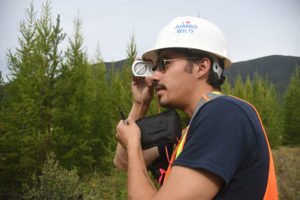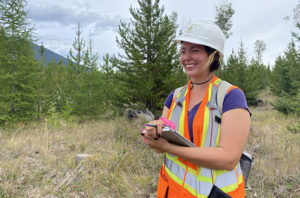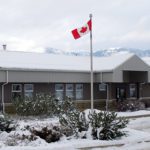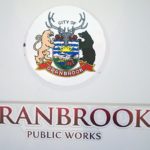Home »

Local youth take action to reduce wildfire risks
Submitted by City of Kimberley / City of Cranbrook
We all want a safe, liveable community. Increasingly across B.C., wildfires threaten to disrupt that safety.
An innovative project took place this year to help safeguard our own community, and protect the surrounding forest, by identifying and understanding what fire risks lie underneath the green forest canopies that border Cranbrook and Kimberley.
 Working alongside wildland fire ecologist Robert Gray, Wildsight’s Youth Climate Corps (YCC) crew surveyed forests that have undergone some form of treatment in the past — areas where possible fuel for a big wildfire (young trees, underbrush, low branches on dry trees, etc.) have been cleared through thinning or controlled burns.
Working alongside wildland fire ecologist Robert Gray, Wildsight’s Youth Climate Corps (YCC) crew surveyed forests that have undergone some form of treatment in the past — areas where possible fuel for a big wildfire (young trees, underbrush, low branches on dry trees, etc.) have been cleared through thinning or controlled burns.
Historically, this type of open forest ecosystem would have been prevalent throughout the lower elevation areas surrounding Kimberley and Cranbrook. Low intensity fires sparked by natural causes or carried out by Indigenous people would have maintained this healthy condition. But decades of aggressive fire suppression practices have changed forests and accumulated much higher levels of wildfire risk, which is further multiplied by the climate emergency now facing us.
The kind of work completed by the Youth Climate Corps will help create more resilient forests with benefits for people and wildlife. Those big fir and larch we love to admire can survive multiple fires throughout their lives if we can keep that fire close to the ground. And in between these big trees we get berries and other useful vegetation for ungulates and humans alike. Reducing the likelihood of uncontrolled wildfires means less devastation for forests and wildlife, and potentially fewer greenhouse gas emissions too.
 Gray has been involved in efforts to make Kimberley and Cranbrook safer from the threat of wildfire for decades, working with local forest professionals and community members to perform wildfire fuel mitigation treatments on crown and municipal land surrounding our communities.
Gray has been involved in efforts to make Kimberley and Cranbrook safer from the threat of wildfire for decades, working with local forest professionals and community members to perform wildfire fuel mitigation treatments on crown and municipal land surrounding our communities.
Until now, little was known about what happens in the forest after the chainsaws have been put down or the controlled burns have ended. How quickly do forests reaccumulate fuels and fire risk? YCC sought to bridge that gap with on-the-ground information. This is a novel project, and one that Gray hopes to see replicated across the province.
“There is currently no program or funding in B.C. dedicated to assessing forest vegetation succession in previously treated areas. But this information is crucial for wildfire professionals to make efficient, economical, and effective decisions for managing wildfire risk into the future,” Gray said.
The six-member Youth Climate Corps crew gathered data near Gold Creek Forest Service Road, the Kimberley Nature Park, and Shadow Mountain. They successfully surveyed more than 600 plots, which provide approximately 2,000 hectares of wildfire information.
 Gray will now analyze the data and strategize on when and where prescribed burning (or other treatment) will be most effective at curbing those fuel sources. In other words, plan for a controlled burn now, to lessen the risk of an uncontrolled burn later.
Gray will now analyze the data and strategize on when and where prescribed burning (or other treatment) will be most effective at curbing those fuel sources. In other words, plan for a controlled burn now, to lessen the risk of an uncontrolled burn later.
“I’m very happy with this data,” Gray said. “It has huge value, and I’m extremely thankful we were able to pull this project together, and that the crew collected all this information.”
Wildsight’s Youth Climate Corps program gives young adults paid training in solid work skills while completing climate-related projects that help protect the environment and build more resilient local communities. Bringing the program to Kimberley/Cranbrook in July 2021 (after a successful inaugural season based in Nelson in 2020) allowed this work to be completed. A second YCC season in the West Kootenay location is also currently underway.
“We were incredibly fortunate to partner with Robert Gray on this project, and we hope to do similar work in the future,” said Tim Chapman, Wildsight Kimberley/Cranbrook YCC coordinator. “Along the way, this work has taught a group of young people about the importance of fire in shaping our local landscape. We were pleased to make wildland safety a priority project for the inaugural YCC crew here in the East Kootenay.”
The Kimberley-Cranbrook Wildfire Research Initiative was made possible with support from Columbia Basin Trust and the Province of BC through the Crown Land Wildfire Risk Reduction Program. Wildsight also thanks the Arjay R. and Frances F. Miller Foundation, BC Parks, Columbia Basin Trust, Eco Canada, Get Youth Working!, Kootenay Career Development Society, Living Lakes Canada, Preston-Werner Ventures, the Province of BC, and our many community partners for making the Youth Climate Corps program possible.
Find more information on the Youth Climate Corps program.








